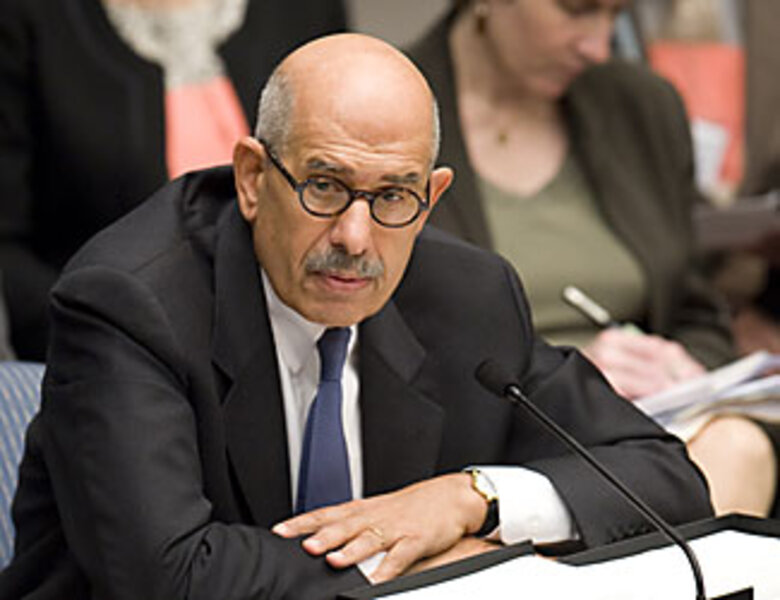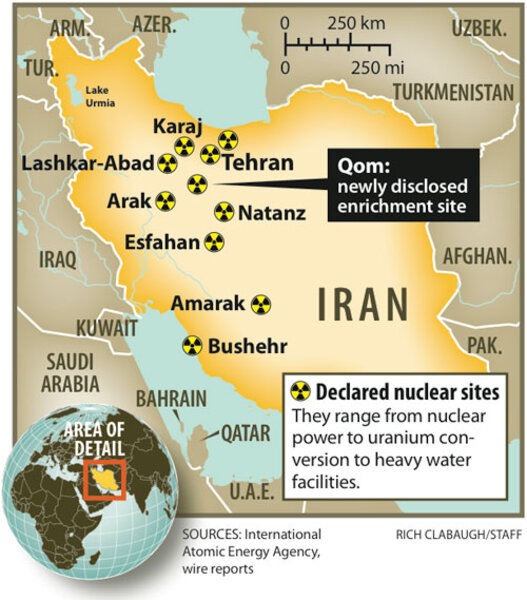Iran's nuclear disclosures: why they matter
Loading...
Gas centrifuges are an amazing technology. They're thin metal tubes that stand upright, about as tall as a fifth-grader, and spin on magnetic bearings that are virtually frictionless. They revolve so fast that when they're filled with uranium hexafluoride gas, the compound separates into isotopes of different atomic weights, with the heavier isotope pushed to the outside by centrifugal force.
They're hard to get running right. Vibration can be a problem, so they must be tuned, a little like guitars. But once an array of centrifuges is humming along, it needs little maintenance. They are a great way to enrich uranium to the point it can be used in a nuclear reactor – or a nuclear bomb.
All this is by way of explanation as to why recent revelations about Iran's hidden centrifuge plant at Qom are so important to the future balance of power in perhaps the most volatile region in the world.
News about Iran's nuclear program has abounded in recent weeks. There was Qom, then allegations that Iran has a secret bomb-design program called "Project 110," and Tehran's surprise offer to perhaps send low-enriched uranium abroad to be turned into reactor fuel.
These and other recent events hint that the pace and complexity of Iran's nuclear program may have increased. Now, Iranian leaders may – or may not – want the bomb. But it seems clear that Tehran wants to develop into a regional power, meaning that time could be short for the United States and its allies to engage with a rising threat in an area crucial to both global energy production and the future of Islam.
"Iran presents the most serious single security challenge in the Middle East," writes Anthony Cordesman, a senior fellow at the Center for Strategic and International Studies (CSIS), in a just-published book on the implications of Iran's weapons programs.
US had been looking for a covert facility
Seen in satellite photos, the newly revealed Iranian facility near Qom looks as if it could be a Wal-Mart, a school, or a factory. But it's intended to house about 3,000 gas centrifuges, according to both Iranian and US officials. In terms of uranium-enrichment capability, that would make it a modest plant.
But to many US proliferation experts, Qom represents the danger of a second fuel cycle foretold. That's because Iran already has a large centrifuge farm, near Natanz. There, it has 8,300 installed centrifuges, though only about half are actually enriching uranium. It is big enough to house 54,000, according to the US.
Natanz itself was revealed to the world by an Iranian dissident group in 2002. Iran says the facility is intended to produce low-enriched uranium (LEU) for use in nuclear power reactors. Today it is under scrutiny by Western intelligence services and International Atomic Energy Agency inspectors, and many experts say it would be difficult for Iran to divert enough LEU from the Natanz production line to produce bomb-grade uranium elsewhere.
That has led many experts outside Iran to this conclusion: If the Iranians want to produce fissile material for weapons, they would be likely to do so at a hidden site. Natanz represents their first fuel cycle. This hidden site, or sites, would constitute the second.
The US intelligence community has predicted this. Two years ago, in their 2007 National Intelligence Estimate of Iran's nuclear intentions and capabilities, US analysts said: "We assess with moderate confidence that Iran probably would use covert facilities – rather than its declared nuclear sites – for the production of highly enriched uranium for a weapon."
So, is Qom this covert facility?
Iran says that it is not and that, like Natanz, it is for civilian uses.
If it were intended to be a secret site, then it is likely that somewhere is also a hidden facility for producing uranium hexafluoride, the centrifuges' feedstock. In fact, some proliferation experts suggest that Iran may have a network of such sites. Or, if it does not already have such a network, Tehran may now start building one, because Qom has been discovered.
That would make keeping tabs on Iran's program something like a high-stakes game of Whac-A-Mole. Miss, and perhaps Tehran gets a nuclear arsenal.
"They hid Qom, and our intelligence agencies found it in the nick of time," says David Albright, a former weapons inspector and president of the Institute for Science and International Security. "We can't count on that next time."
Conflicting intelligence reports
Obtaining fissile material, such as plutonium or highly enriched uranium, is the hardest step in producing the bomb. But it is not the only step. Nuclear weapons are complex devices that require high-voltage firing systems and associated detonators. Pieces must be machined to incredibly precise tolerances if they are to fit together and work.
Handing someone the blueprint of a bomb is not tantamount to giving him nuclear capability. Producing the stuff from that blueprint is a difficult art.
According to US intelligence, Iran has worked on such components in a weaponization process. But US agencies also conclude that Tehran stopped that work in 2003.
Intelligence analysts in some other countries, such as Germany, disagree – and insist Iran is still busy with weaponization work. Apparently that is also the view of some officials at the UN's International Atomic Energy Agency (IAEA).
An IAEA report leaked to the press in early October alleges that Iran's Project 110 is continuing its clandestine effort to produce a nuclear warhead small enough to sit atop a missile. "Project 111" is corresponding work aimed at reshaping space inside the nose cone of a Shahab 3 missile so that the warhead will fit.
The IAEA report concludes that Iran has "sufficient information to be able to design and produce a workable implosion nuclear device." But the paper has fierce detractors within the agency, who contend that some of the intelligence behind this conclusion could be forged.
Some outside experts, moreover, note that the parts of the report made public so far don't have many dates associated with Iran's alleged activities. That means it is possible that Iran had a Project 110 at one time, but has since scrapped it, as US intelligence continues to insist.
"I'm suspicious of 'spinning' on both sides of this issue," says Greg Thielmann, a former US intelligence official who is now a fellow at the Arms Control Association.
As to the pace of Iran's progress, it is conceivable that Tehran could build its own nuclear device as early as this year, according to Mr. Cordesman of CSIS.
But it is more likely that the time frame for deployment of actual weapons, on top of missiles, would be 2011 to 2015, he writes in his new book.
"Iran seems to be developing all of the capabilities necessary to deploy a significant number of nuclear weapons no later than 2020 and to mount them on missile systems capable of striking at targets throughout the region and beyond," Cordesman writes.
Hope for real nuclear negotiations: slim, but present
So, that's it then? It's inevitable that Iran is going to join the nuclear club?
That's not necessarily true, say other experts. There are some hopeful signs that Iranian leaders remain open to real nuclear negotiations.
For instance, on Oct. 1 Iran agreed in principle to send most of its openly declared LEU out of the country, probably to Russia. There, it would be turned into fuel for a small Iranian reactor that produces medical isotopes.
If this shipment comes to pass – and that is a big "if," considering Iran's past behavior – it would be a positive step. No longer would Tehran have at its disposal a pile of material it could easily enrich into bomb fuel.
The key is the intentions of Iran's leaders. Those are unknown to the US and its partners in negotiations.
If Iran is determined to get a nuclear bomb – and if a consensus exists in Iran's government behind that objective – there may be no stopping it. No negotiations or agreement with the US and other nations would help, according to Matthew Bunn, a principal investigator at the Project on Managing the Atom at Harvard University's John F. Kennedy School of Government.
"They would either reject or violate measures that would seriously constrain their program," said Dr. Bunn during a recent presentation on how to deal with Iran's program.
However, if views differ within Iran's hierarchy about how close to get to nuclear weapons capability, then a negotiated deal could have an effect on the program's future.
By proffering incentives for Iran to change its behavior, the West could strengthen the hand of any Iranians in favor of a less confrontational approach, said Bunn.
But time and flexibility are needed to strike such a bargain. After decades of intense hostility, neither the US nor Iran trusts the other.
"Ultimately, to get Iran to address [the concerns of the US and its allies], the [US and its allies] must address Iran's concerns," said Bunn. "A deal not seen as serving Iran's interests, as well as ours, will be rejected or will fail."






